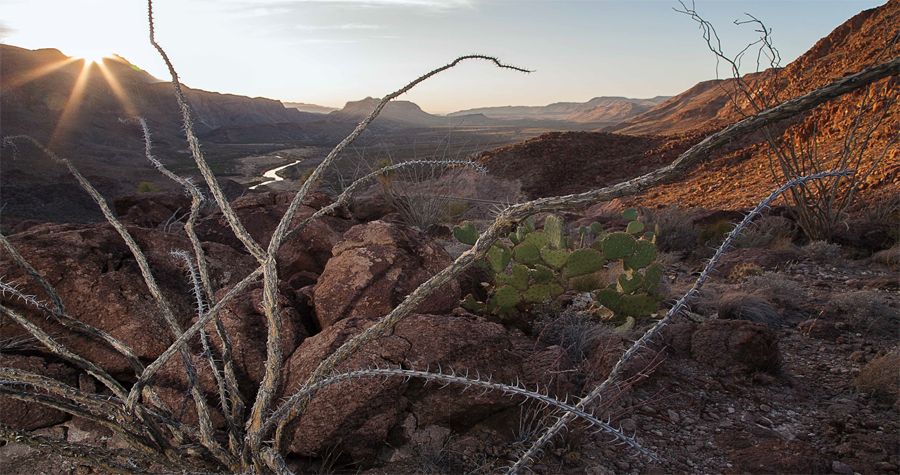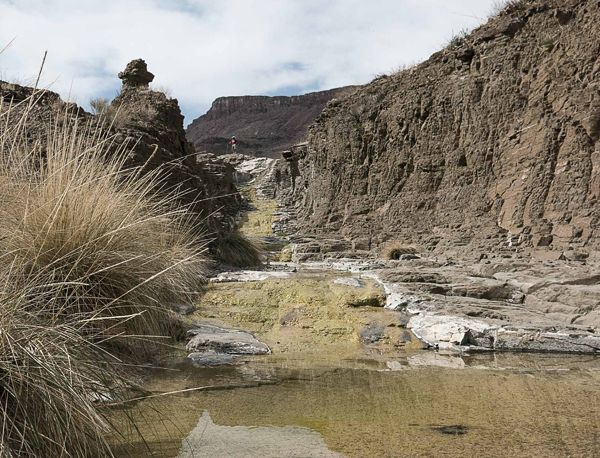
A few miles from the studio, up Fresno Canyon, a collection of natural rock pools called tinajas overflow with rainwater. The tinajas, carved by erosion, are filled through a network of grooves channeling the runoff between narrowing canyon walls. Some tinajas are deep, especially after a flood scours them of debris, leaving only water. Others are clogged with silky clay. Water leaves the tinajas over steplike ledges, descending to the canyon floor before disappearing into the gravel. Trevizo and I negotiated this stretch in the dark one evening after a long day of canyoneering. Without headlamps or a moon, only starlight illuminated the way. The tinajas mirrored the pinpoints overhead, confounding our efforts as the sky merged with the ground.
Above the tinajas, a rock ruin makes a windbreak for roaming coyotes. A cotton rat occupies the remains of its collapsed ceiling, constructed of mud and ocotillo branches known as latillas. Below, the canyon widens into a sandy arroyo bound by layered cliffs of mudstone, tuff, and sandstone. Heavy rains cause unstable sections to collapse like upended stacks of pancakes.
Past the tinajas, a mountain bike trail leads to the Whit-Roy Mine site, an abandoned quicksilver operation located along the canyon’s eastern edge. The trail leaves the mine along the remains of a road used by miners to cart supplies from Marfa. Improvements made to the route are evident in the collapsing dry-stack and mortared shoring where the road climbs the edge of the canyon. On top, the road bisects creosote and ocotillo flats before crossing an arroyo by a short suspension bridge constructed from timbers, iron rods, and heavy cable. A patina covers the collapsing bridgework, a burnt-toast glaze like the crust on petroglyphs. Extra planks, placed lengthwise, make crossing the bridge possible, but the timbers sag beneath the weight of the bikes.
The canyon’s eroded rock ledges contain carved holes in places, hollowed out like test tubes. Archaeologists suppose the cavities are archaic reservoirs where water, grains, or other substances were stored. A drainage called Arroyo Primera enters the canyon north of the ledges, providing an important source of runoff for Fresno. A tiny cabin and a makeshift corral occupy a small cleared area below the confluence. The cabin and corral sit beyond the canyon’s flood zone, sandwiched between rocky bluffs and a short drop to the canyon’s floor. Built by Sleeper and called Los Escalones a Gloria, or “Stairway to Heaven,” the cabin functioned as a gathering point for Sleeper’s “vision quests.” On a long hike up the canyon, the cabin’s tiny porch offers shade and a place to store extra water. One evening we camped there, making a fire for cooking steaks and sleeping on bedrolls stretched along the ground. Around midnight, lightning and pelting rain drove us inside. The storm stalled above Arroyo Primera, pounding the cabin for half an hour. The lightning continued to illuminate the landscape even after the storm moved on up the canyon. Between thunder claps, the sound of runoff could be heard roaring down Arroyo Primera and draining into Fresno. A wall of water swept the canyon floor, floating branches and rolling gravel, making a whooshing sound like air moving through leaves. After the floodwater passed, hundreds of fireflies emerged from the damp soil, strobing like LEDs. When lightning flashed, the fireflies paused, cloaking the canyon in darkness before pulsing back to life. They drifted phantomlike, slowly floating down the canyon and out of sight.
West of Fresno, Tapado Canyon follows a wide, shallow wash before making a sharp right turn, signaling a dramatic change in the topography. The expanse of this first mile, a big bouldery promenade, accommodates the tremendous runoff traveling down the canyon from Tapado’s upper reaches during heavy storms. After making the right turn, the canyon lives up to its name, a Spanish word for covered, closed, or blocked. The walls come together for the next seven miles, squeezing a half-dozen springs to the surface and reaching a thousand feet high in places. Midway to its major spring, called Oso for the black bears that traveled the canyon, the walls are no wider than an arm spread, cutting a slender path between black basalt.
Closer to home, Panther Canyon makes a challenging hike with its steep walls and rough, narrow passageway. Large boulders and vegetation obstruct the route, requiring a scramble up loose rockfall to negotiate blocked sections. A spring called Ojo de Torribio marks the remains of a massive tree struck by lightning. Limbs of the giant cottonwood are wedged between boulders all the way down the canyon.
The canyon shelters a small historic site known as Casa Reza. The site anchors a level patch near a brushy seep with a view of the treetop canopy. Its adobe ruins and the attendant jetsam of desert life were left by the Rezas family almost a hundred years ago. The family spent their days tending an orchard, a vegetable plot, and a herd of goats. They produced asaderos, a cheese made from the goats’ milk, and sold it, along with fruits from the orchard, a burro ride away in the small river settlements of Polvo and Lajitas.
Panther Canyon’s shelters, ledges, seeps, and springs provide habitat for predators and prey alike, including mountain lions, giving the canyon its name. Their pug-marks appeared but never the cats, although I imagine we’ve been spotted and tracked by a few. The canyon’s late-winter skies, usually warm and cloud-free, furnished a backdrop for tarantula wasps and drifting gossamer pushed along by a breeze working up the canyonway. The light penetrated the last of the cottonwood leaves, sun dried and copper, and brightened the bleached limbs, green-specked with new buds.
After a hike to Ojo de Torribio, followed by lunch and a nap, we considered climbing the canyon wall and trekking cross-country back home. But the food and the reverie made me lazy, so we stuck to the canyon’s watercourse instead, wet and slick at first then chalk dry, sliding off boulders and landing in pits of gravel and sand before the canyon dumped us out for good.
